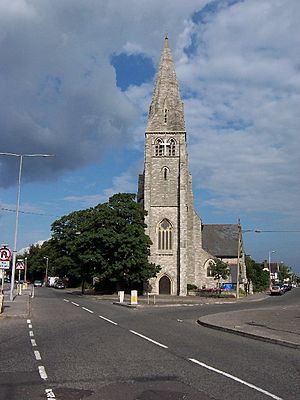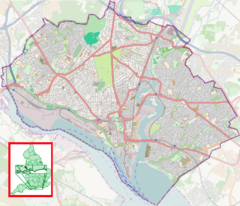Freemantle facts for kids
Quick facts for kids Freemantle |
|
|---|---|
 Christ Church, Freemantle |
|
| Unitary authority | |
| Ceremonial county | |
| Region | |
| Country | England |
| Sovereign state | United Kingdom |
| Post town | SOUTHAMPTON |
| Postcode district | SO15 |
| Dialling code | 023 |
| Police | Hampshire |
| Fire | Hampshire |
| Ambulance | South Central |
| EU Parliament | South East England |
| UK Parliament |
|
Freemantle is a neighbourhood and an area for local elections (called an electoral ward) in Southampton, England.
You might find other places in Hampshire with similar names. For example, there's a hunting lodge that belonged to King Henry II in Kingsclere. There's also an area near Hannington and Freemantle Common in Bitterne. People used to think these names came from French words meaning "cold cloak." But now we know they come from the word fromental, which means a field of wheat.
Contents
History of Freemantle
Freemantle started as a large house and its surrounding land within the area of Millbrook. Before that, it was a farm. In 1851, Freemantle became its own separate area, or "parish." However, some old records still say it was part of Millbrook.
The last owner of the Freemantle House and Estate, Sir George Henry Hewett, sold it in 1852. A local businessman named Sampson Payne bought it. Sampson Payne was a merchant and also developed properties. He was a town councillor for many years and even served as the Mayor of Southampton from 1854 to 1856.
Sampson Payne then sold the land in smaller pieces to different property developers and building societies. Soon after, he also created almost twenty new roads through the area.
Building the Neighbourhood
Freemantle began to be built up in the 1850s. Most of the houses there today are small Victorian homes, either semi-detached (joined to one other house) or terraced (joined in a row). The local school was built in 1857, and the church was finished in 1865.
From 1880 to 1895, Freemantle was managed together with another area called Shirley. This was done by a group called the Shirley and Freemantle Urban District Council. This council was first set up as a "Local Board of Health." In 1895, Freemantle officially became part of the Southampton borough.
Christ Church Freemantle
Christ Church is the main church for the Freemantle area. The idea for a church community here started in 1856. At first, church meetings were held in the Bailiffs House, and later, services took place in the school rooms.
On July 25, 1861, the first stone of the church was laid by Archdeacon Jacob. Then, on July 27, 1865, the church was officially opened and blessed by Dr. Sumner, who was the Bishop of Winchester. On April 19, 1866, the Ecclesiastical Commission of England agreed that Freemantle would be a separate church district from Millbrook. They declared the new church as the Parish of Christ Church, Freemantle. The church's tall tower and spire were added later in 1875.
Freemantle Common
It can be a bit confusing, but there is also a place called Freemantle Common in Southampton. This common is actually quite far from the Freemantle neighbourhood itself. It is located in the area of Bitterne.
Civil Service Sports Ground
The largest green space in Freemantle used to be the Civil Service Sports Ground. This field, which is about 8 acres (32,000 square metres) in size, has been used for sports and community events since the 1700s.
Between 1888 and 1905, it was the home ground for Freemantle F.C., a football team that was a rival to Southampton F.C.. At one point in 1897, Southampton F.C. even thought about joining with Freemantle F.C. and moving to this ground.
Changes to the Sports Ground
The Atherley family owned the land and sold it to the Civil Service in 1927 for £5000. It was sold as a working sports ground with all its facilities. There was also an agreement, called a "covenant," that the land should only be used for sports.
The sports ground closed in 1999 after seventy years of use by the Civil Service. In its last few years, the land started to fall apart. There were fires at the clubhouse in 1999, and by 2003, the fences had broken down. People started illegally dumping rubbish there, and at one point, a group of travellers stayed on the site.
The City Council had to pay for every cleanup. Because of this, and a long campaign by local residents to "Save The Field," the Council looked into buying the site. This process is called "compulsory purchase."
Community Efforts to Save the Field
In 2004, the owners of the land, Civil Service Property Holdings Ltd, decided to sell the site. They asked for bids in a private process. Local residents, a group called "Friends of The Field," and local councillors from both the Conservative and Labour parties (supported by local MP Alan Whitehead) tried to talk with the owners. However, they were not successful.
Most of the site was sold to a house-building company called Bovis Homes for about £160,000. However, the council had not given permission for any building plans. There is still strong support from local people and politicians to make sure the site can be used by the community.
Southampton City Council eventually bought the field. This happened after more than ten years of campaigning by the Friends of The Field Community Association. Many groups, including local councillors, Members of Parliament (MPs), Members of European Parliament (MEPs), school groups, and residents, were involved.
As of 2017, the future of "The Field" was still being decided. People hoped it would be used by the local community, including schools and residents, for sports, learning, and fun. Many local groups want to work together with schools, the Council, and the community to create a true "Community Hub" for everyone. The "Friends of The Field" campaign has been working on this for over 13 years.


